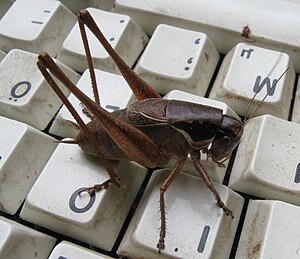Coast Shrub Insect
| Coast Shrub Insect | ||||||||||||
|---|---|---|---|---|---|---|---|---|---|---|---|---|

Coast shrub insect ( Pholidoptera littoralis ) |
||||||||||||
| Systematics | ||||||||||||
|
||||||||||||
| Scientific name | ||||||||||||
| Pholidoptera littoralis | ||||||||||||
| ( Fever , 1853) |
The coastal shrub insect ( Pholidoptera littoralis ) is a long-probe insect from the subfamily of the Tettigoniinae within the superfamily of the grasshopper . There are three subspecies.
features
The coastal shrub insect is similar to the southern shrub insect , but is slimmer and longer-legged. Your pronotum is slightly elongated backwards. The species is predominantly monochrome and brown with little contrast and often also has green areas. The pronotum lateral lobes are dark brown to black in color and have a broad, light yellow to whitish or greenish yellow border. The black color on the pronotum continues forward over the head, ends at the antennae and is divided behind and above the eye by a more or less wide, light line diagonally upwards and backwards. Often the underside of the body including the thighs of the pairs of legs (or parts of them) is light green. The receded wings reach almost to the middle of the abdomen and are veined light yellow. The antennae are slightly longer than the body, the compound eyes are brown with a dark point in the middle. The male has unusually long cerci that are toothed in the first quarter or just behind. The ovipositor of the female is body-long and barely curved. The coastal shrub insect reaches a body length of 22 to 28 millimeters.
In southern France and on the Adriatic coast , very similar species of the genus Pholidoptera can sometimes be found .
Way of life and distribution
Contrary to what the name suggests, the coastal shrub insect can be found not only on coasts, but also in large areas inland and even in low mountain ranges. It inhabits meadows, clearings, bushes and (as already mentioned) low mountain ranges. It often occurs in the same areas as the southern shrub insect and is often associated with it. The coastal shrub insect is very nimble and therefore difficult to catch in dense vegetation. Its distribution area extends from Greece over large parts of the Balkan Peninsula via the Italian Alpine foothills, Switzerland and Austria to Germany, the Czech Republic, Poland and Slovakia , where it does not occur as often, however, or where it is passively carried off or where it has been released (such as in Munich). Adults occur from June to October.
Systematics
So far, three subspecies have been distinguished:
- Ph. L. littoralis (fever, 1853) - represents the nominate form - widespread in Switzerland , Austria , Germany , the Czech Republic , Poland and Slovakia
- Ph. L. insubrica Nadig, 1961 - widespread in Switzerland , Austria , Germany , the Czech Republic , Poland and Slovakia
- Ph. L. similis (Brunner von Wattenwyl, 1861) - is widespread on the Balkan Peninsula
swell
literature
- Heiko Bellmann : The Cosmos Locust Leader. Determine the species of Central Europe with certainty. Franckh-Kosmos Verlags GmbH & Co. KG, Stuttgart 2006, ISBN 3440104478
- Glaw, Frank (2009): First record of the coastal shrub insect (Pholidoptera littoralis) in Germany (Insecta, Saltatoria). - Bulletin bayer. Ent. 58 (1/2): 18-24
Web links
Individual evidence
- ^ Glaw, Frank (2009). First record of the coastal shrub insect (Pholidoptera littoralis) in Germany (Insecta, Saltatoria). Bavarian Entomologists' Newsletter, Volume 58 (1/2): 18-24.